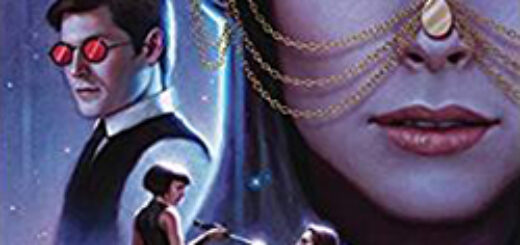Emily S. Whitten & Chris Roberson – Serenity: No Power
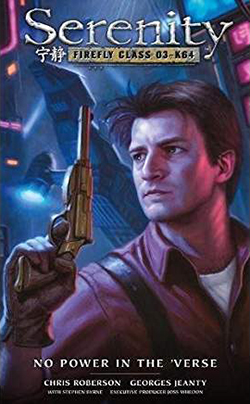 I always love talking with creators about their process, and I’ve been a fan of Firefly for years now So it was a pleasure to sit down with Chris Roberson, writer of Serenity: No Power in the ‘Verse, to chat with him about his experience creating this tale. Chris offered some cool insights into his writing process, and, of course, we both geeked out over the world of Firefly and our mutual fandom. Read on for the full interview below!
I always love talking with creators about their process, and I’ve been a fan of Firefly for years now So it was a pleasure to sit down with Chris Roberson, writer of Serenity: No Power in the ‘Verse, to chat with him about his experience creating this tale. Chris offered some cool insights into his writing process, and, of course, we both geeked out over the world of Firefly and our mutual fandom. Read on for the full interview below!
Emily: What is it like for you playing in the ‘Verse, when there is so much to it, and there’s such a great world that’s already been built?
Chris: It was incredibly intimidating. I was a fan from the day that “Train Job” aired. And they aired out of order. Kids; they don’t understand that not only did they not air all the episodes, but they were in the wrong order! So I was there the whole time in the audience. And I was a rabid fan. When the prospect of working on the book first came up a few years ago…the gestation of the book was fairly long. It was the better part of three years from when I was initially offered, “Hey, would you like to do this?” to it actually being done. I worked with four different editors over the course of that time.
So as a fan it was incredibly intimidating. Because it was super fun, and I was like, “Cool, I get to do all this stuff!” but at the same time, I didn’t want to disappoint the rabid fanbase.
Also, I was able to justify all kinds of purchases that otherwise I wouldn’t have bought. Quantum Mechanix’ Atlas of the ‘Verse, and all that stuff; and blueprints of the ship – that was a work expense.
I needed the blueprints just to figure out, like, “How do you get from this room to this room in the ship?” When you’re watching the show, it’s often hard to tell, because of the way it’s edited around. I’m like, “Wait a minute, how do you get from the cargo deck to that room?”
E: I know what you mean because sometimes in the show it’s hard to tell where they’re coming from. Like that one scene where Kaylee throws Mal the wrench so that he can get into the hatch, and I’m thinking, “Where is he going from and to?”
C: Yeah – and also where the interior of the ship maps to the exterior, was something that I had to spend some time figuring out.
E: And then of course there’s the mix of English with Chinese. Did you have any background in that?
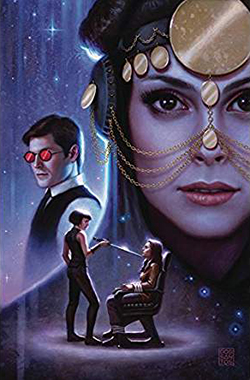 C: Oh God no! If there was anything I had to justify more in every script, it was those. Those are sourced directly from the scripts. There are several-volume collections of all the scripts from the show and also from the film. I referenced those heavily. In the scripts I think they would be written out, but then I would have to reference something else to get it into the right characters. And luckily in the back of the most recent role-playing game there’s a thing in there of all of them transliterated, so I was able to drop those in. But in almost every case I would have to say, “Okay, that line was spoken by this character in this episode;” and then I had to send scans of the pages from the role-playing game to the editor to say, “Here’s where I’m getting this from.”
C: Oh God no! If there was anything I had to justify more in every script, it was those. Those are sourced directly from the scripts. There are several-volume collections of all the scripts from the show and also from the film. I referenced those heavily. In the scripts I think they would be written out, but then I would have to reference something else to get it into the right characters. And luckily in the back of the most recent role-playing game there’s a thing in there of all of them transliterated, so I was able to drop those in. But in almost every case I would have to say, “Okay, that line was spoken by this character in this episode;” and then I had to send scans of the pages from the role-playing game to the editor to say, “Here’s where I’m getting this from.”
E: That’s very complicated.
C: Yeah. It’s the job.
E: Well, and writers enjoy that kind of stuff. Otherwise why would you be a writer?
C: I love research.
E: What, if any, input did Joss have, or what kind of guidance were you given about where to play or how to play in the ‘Verse?
C: It was more from the other direction. It was me suggesting things and asking questions and then being told what I could and couldn’t do. And in almost every instance – they said yes to, I think, pretty much everything I suggested. It was a strange experience, in that the comic is now the canon. Because normally when you’re doing licensed work – and I’ve done a lot of it – your job is like, to shake all the toys out of the box, play around, have a cool story, and then put them all back where they belong. So when you’re doing licensed stuff, you’re often slotting a story in between these two episodes, or this season and that season. But because the show ended and now this is the show, essentially, the pushback I kept getting was that I wasn’t changing things. I wasn’t making enough difference in the status quo. Because I kept basically getting everything back together again at the end. I had to mess some stuff up. And that was one of the things that was really intimidating. It was like – people are going to be mad at me. Because I’m screwing stuff up for these characters; but they made me. They forced me to.
E: I was going to ask you about fan reactions, and that plays right into this. Because, particularly I noticed (SPOILER ALERT!) that Mal and Inara have some back-and-forth that is worrying, especially at the end. And at this point, they’re a couple, which is also a different thing than in the show, so if people haven’t been reading the comics, they wouldn’t know. Fans might be happy, but…then there’s also that weird thing with Jayne and Zoe and – poor Jayne, is he ever going to be not lonely? So tell me about working on those relationships, and any fan reactions?
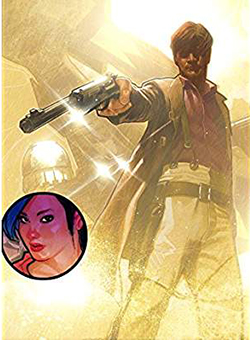 C: I was basically picking up threads that had been laid down in Leaves on the Wind, the previous series that Zach Whedon had done with Georges Jeanty. It was interesting to me to see the way that those relationships had developed. That River had kind of taken Wash’s place in a lot of ways; in that she was the pilot, but also that she had this kind of almost co-parenting thing? We didn’t see that there, but I could see that it was a possibility. She was definitely filling a hole that was left when Wash was gone. So beginning No Power in the ‘Verse, the crew is kind of broken down into these mini subsets, these pairs and trios. And yeah, Jayne is not in one. He’s him, so he’s just kind of bouncing around. So a lot of where the plot came from was: look at each of those little clusters of characters, and see where is an interesting place to put strain.
C: I was basically picking up threads that had been laid down in Leaves on the Wind, the previous series that Zach Whedon had done with Georges Jeanty. It was interesting to me to see the way that those relationships had developed. That River had kind of taken Wash’s place in a lot of ways; in that she was the pilot, but also that she had this kind of almost co-parenting thing? We didn’t see that there, but I could see that it was a possibility. She was definitely filling a hole that was left when Wash was gone. So beginning No Power in the ‘Verse, the crew is kind of broken down into these mini subsets, these pairs and trios. And yeah, Jayne is not in one. He’s him, so he’s just kind of bouncing around. So a lot of where the plot came from was: look at each of those little clusters of characters, and see where is an interesting place to put strain.
Because basically these people are locked in a building together always. So whatever friendship or relationship – romantic, platonic, whatever, they have – if you can’t leave, forever, there’s going to be strain.
E: It’s an interesting dynamic to work with.
C: Yeah – it’s like being stuck in a hotel forever. So those are the points where I thought, “Oh yeah. People are going to be mad.” But by and large, certainly I think Joss has trained a viewership and readership that expects bad things to happen to his characters, right? I love all those characters, but it couldn’t just be five issues of everybody having birthday cake, and having fun. That’s not a story. So that’s what the story turned into, was like, do those then re-form in certain ways, once those have been broken apart? Or do they change shape a little bit?
E: Of course, on top of that we’ve got the larger story of the Alliance and Calista and her group of creepy followers trying to get River back. Did that come out of – I don’t know if I want to spoil things – but it builds up into something that looks like in the next story, it’s going to be a really epic thing. Where did that come from?
C: There is a document – I’m not sure if I remember what the provenance of it was – but it’s included in several of the companions, and in the role-playing game. But Joss wrote it in the early days, I think to give the writers and the crew initially an idea of how this world worked. It’s a brief history of the ‘Verse, about 1,000 to 2,000 words long, written in the vernacular of the show; a history of what’s happened before now. It’s like a more elaborate version of that spoken-word intro that you got in the pilot. But in there, he talks a lot about the war, but there’s a line in there about soldiers who weren’t happy to lay down their arms – these Peacemakers. And it had actually been mentioned and visited in one of the earlier comics. But I felt like that was an interesting thread to pull, because Mal had broken in his own way, but there were a ton of other soldiers out there, and what are those guys up to? And maybe they still have axes to grind. Just looking at real examples from history, people have different agendas. We might agree that those are the Bad Guys, but how far are you willing to go? What are you willing to do? So that’s largely where those characters came from, was this offhand reference.
One of the other threads I found – I realized there was a story hidden in Inara’s backstory that had never been explored.
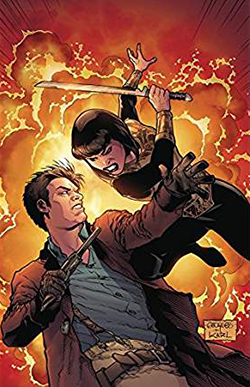 E: That was very interesting to me too. It kept being mentioned, and no one knew why she had left, and then you pulled that out.
E: That was very interesting to me too. It kept being mentioned, and no one knew why she had left, and then you pulled that out.
C: I noticed that in reading through the scripts. It’s right there. It’s mentioned fairly early on – she left under a cloud; this was not her first choice, to go out and live in dirt, basically, this really classy lady. So that was a fannish question of mine – “Let’s see what’s back there? What’s interesting about that? What would cause her to have to do that?”
E: No Power in the ‘Verse is out in hardcover now. So what is coming next here? Are you working on something else with this?
C: I don’t know what their next plans are. I have been told that they are doing more stuff, but I don’t know what it is.
E: Okay, well I’ll keep hoping, because you set something up here that I want to know more about – what are Mal and the crew going to do next? But also, you had mentioned working with Georges Jeanty. I’ve known Georges and his work for a long time, and he has a history of working on this type of series, like Buffy, and Firefly, that have ended in the show, but then they’ve come into the comics world. So what’s that collaboration like?
C: Oh, it’s great! I mean, I really like when a collaboration is really collaborative. It sounds trite but it’s true. Like, I don’t feel like, “Here are your marching orders; go do this thing.” Because I always try as much as possible to solicit input and suggestions on the story side of things from the artist. And there is a gag, a long-running gag in the book, that was entirely Georges’ suggestion. The one with Jayne and the hats, the sweaters… That was him.
E: Well bless him for that one, because that did make me laugh.
C: And as soon as he said it, I was like, “Oh, yeah, that’s perfect!” It also helped give a much-needed lightness to it. Because it’s a really heavy story. You gotta get some jokes in there somewhere. So that basically was Jayne’s job in the book.
E: Well here’s the next question – how does his ma always know where he’s gonna be?
C: That was actually something I had to work out the logistics of, and I went back – in that episode where he gets the hat, it’s kind of set up that they check in to see if there’s mail for them. So somehow the way the ‘Verse works is they’re basically “Mailbox, Inc.,” but on different planets, and these guys are going from planet to planet but occasionally check in to see, “Is there anything here for us?”
E: That makes sense. I noticed in reading that there’s a great balance between the characters and the action. Do you, as a writer, have to consciously work on that? Because this is a story with a lot of characters – a Badass Crew! And on top of that, an action series. How do you deal with that as a writer?
C: I start with the visuals, so my scripts always begin with…the first things I write are the panel descriptions. Which are basically my suggestions to the artist, how I think they’re going to draw. Like, “In my head, this is how I think you and your style would do it; if you have a better idea, do that.” And only after I’ve written the entire issue’s-worth of those do I go back and figure out, “Okay, what has to be communicated verbally? What has to be spoken?” And then I put as little of that in as I can.
E: Very cool. I noticed in the back of the hardcover trade, we also have a little fairy tale, which is super cute. I assume that came out as an individual issue?
C: It was actually included in last year’s Free Comic Book Day offer.
E: So how did that happen?
C: Well, the book hadn’t even been announced, but they asked me if I would do a Serenity piece for FCBD, and did I have any ideas. The art is by Stephen Byrne. And Stephen had done a bit of fan art a year or two before that that was like, Disney-Serenity. And so I was like, “Okay. How do we get to there?” And I ripped the plot off entirely from an early ’80s issue of Uncanny X-Men, where Kitty Pryde is telling Illyana Rasputin basically what the X-Men have been doing the last couple of years as a fairy tale. So in that way I was able to tackle some pretty heavy storylines. Like the death of Jean Grey was one of the things that was included in this fairy tale version of the story.
E: Yeah, and this of course tackles Wash, and that is a really interesting way to do that.
C: So I suggested Stephen. I said I would love to have him. I was assuming Joss would be cool with it because Joss already liked his fan art, and I think that was the only written feedback that I got from Joss. He just said, “Charming,” or “Utterly charming,” or something like that. And I was like, “All right, I’ll take that!” It also made people cry.
E: It did tug my heart strings a little bit there. So with Emma, the cute l’il baby, and also Bea and Iris, who we haven’t seen as much of, and obviously not in the show, what’s it like crafting new characters in this ‘Verse?
C: It’s an interesting challenge. Particularly with those two, taking a character who was basically what River would have been if she hadn’t been busted out, and is now being kind of deprogrammed, running around the galaxy having adventures. It was fun, to see, “What’s that like? What have they been doing?” We don’t get to spend as much time with them as I would like.
E: Anything else you’d like fans to know about this book? Or about your other work?
C: It’s out now, it’s gorgeous, it’s super good! Mostly what I do these days is set in the world of Hellboy, so they can check that out.
Thank you, Chris, for sitting down with me for this interview (and Dark Horse for setting it up). Check out Serenity: No Power in the ‘Verse, out in hardcover now.
And until next time, Servo Lectio!

